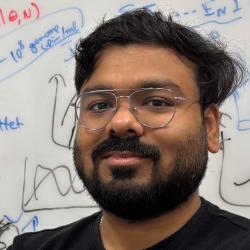Four College Researchers Win American Physical Society Awards
Four researchers in the University of Maryland's College of Computer, Mathematical, and Natural Sciences won major awards from the American Physical Society, the nation’s largest professional organization of physicists. They are Gretchen Campbell, Christopher Monroe, Edward Redish and Ian Spielman, each honored in a different category. All four have appointments in the UMD Department of Physics. In addition, Campbell, Monroe and Spielman are Fellows of the Joint Quantum Institute (JQI), a joint research partnership between the University of Maryland and the National Institute of Standards and Technology (NIST).
Gretchen Campbell, of NIST's Quantum Measurement Division and a UMD adjunct professor of physics, won the Maria Goeppert Mayer Award, created “to recognize and enhance outstanding achievement by a woman physicist in the early years of her career, and to provide opportunities for her to present these achievements to others through public lectures.”
After completing a Ph.D. at MIT, Campbell was an NRC Postdoctoral Fellow in Jun Ye’s group at NIST, Boulder. She joined JQI as a Fellow in 2009 and currently runs two laboratories: one at NIST and one at UMD. At NIST, her lab studies superfluidity in an atomtronic circuit. Atomtronics is an emerging technology whereby atoms play the role of information carriers, analogous to electrons in conventional circuitry. Campbell’s lab has led the research progress in this area.
Campbell was chosen for “her pioneering contributions to the study of superfluidity in atomic-gas Bose-Einstein condensates, realizing atomic analogs to superconducting and superfluid liquid circuitry, including the use of weak links to create the first closed-circuit atomtronic devices.” Last year’s winner was UMD alumna and JILA Fellow Ana Maria Rey.
Christopher Monroe, the Bice Zorn Professor in the UMD Department of Physics, won the Arthur L. Schawlow Prize in Laser Science, awarded “to recognize outstanding contributions to basic research which uses lasers to advance our knowledge of the fundamental physical properties of materials and their interaction with light.”
Monroe completed his Ph.D., under the direction of Carl Wieman in 1992. His career in ion traps began when he was an NRC Postdoctoral Fellow in Dave Wineland’s group at NIST, Boulder. In 2007 he joined JQI, where he currently has five operational ion trapping laboratories. His labs explore a range of physics and ion trap technology. Notably, Monroe’s research group has been a leader in quantum simulations using trapped atomic ions, as well as the development of a modular, scalable architecture for quantum computing.
Previous winners of the Schawlow prize include Nobel laureates David Wineland, John Hall, and William Phillips of NIST, Carl Wieman of JILA, Steven Chu of Stanford, and many other distinguished scientists.
Edward Redish, UMD professor of physics, won the Excellence in Physics Education Award, created "for leadership in the use of computers in physics education, applying cognitive research to improve student learning and critical thinking skills, tailoring physics instruction for nonphysicists, and guiding the field of physics education research through a period of significant growth."
Redish joined UMD in 1968 and climbed the ranks from assistant professor to department chair of physics and astronomy. He has received the University System of Maryland Board of Regents Award for Teaching and the National Science Foundation Director's Award for Distinguished Teaching Scholar and was named a UMD Distinguished Scholar Teacher. He is a Fellow of the American Physical Society, the American Association for the Advancement of Science and the Washington Academy of Sciences.
Ian Spielman, of NIST’s Quantum Measurement Division and a UMD adjunct professor of physics, won the I.I. Rabi Prize in Atomic, Molecular and Optical Physics, awarded “to recognize and encourage outstanding research in atomic, molecular and optical physics by investigators who have held a Ph.D. for 10 years or less.”
Spielman earned his Ph.D. from Caltech in 2004. After an NRC (National Research Council) Postdoctdoctoral fellowship in NISTs Laser Cooling and Trapping group he was hired a physicist in that same group. He currently operates three research laboratories, one on UMDs campus in College Park and two at NIST, Gaithersburg. Spielman’s group has spearheaded innovative, versatile techniques that make neutral ultracold atoms behave unexpectedly, in some cases like charged electrons.
Spielman was cited for “the development of quantum simulations using ultra-cold atoms, creation of synthetic electromagnetic fields, demonstration of synthetic spin-orbit coupling, and applications to studying new physical systems.” Previous winners include Nobel laureates Eric Cornell and Wolfgang Ketterle, as well as UMD’s Christopher Monroe and Jun Ye and Deborah Jin of JILA, a partnership between NIST and the University of Colorado.
Media Relations Contact: Abby Robinson, 301-405-5845, abbyr@umd.edu
University of Maryland
College of Computer, Mathematical, and Natural Sciences
2300 Symons Hall
College Park, MD 20742
www.cmns.umd.edu
@UMDscience
About the College of Computer, Mathematical, and Natural Sciences
The College of Computer, Mathematical, and Natural Sciences at the University of Maryland educates more than 7,000 future scientific leaders in its undergraduate and graduate programs each year. The college's 10 departments and more than a dozen interdisciplinary research centers foster scientific discovery with annual sponsored research funding exceeding $150 million.







